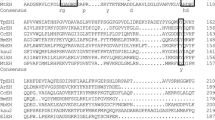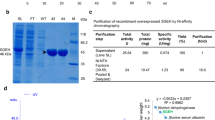Abstract
A Pseudomonas sp. was isolated with enantioselective epoxide hydrolase activity to ethyl 3-phenylglycidate. Cells grown on sucrose and suspended in 10% (v/v) dimethyl formamide as co-solvent produced (2R,3S) ethyl 3-phenylglycidate with 95% ee and 26% yield in 12 h from 0.2% (w/v) of the racemate.
Similar content being viewed by others
References
Archelas A, Furstoss R (2001) Synthetic applications of epoxide hydrolases. Curr. Opin. Chem. Biol. 5: 112–119.
Argentine JA, Anthony JA (1995) Characterization of a salivary gland-specific esterase in the vector mosquito. Aedes aegypti. Insect Biochem. Mol. Biol. 25: 621–630.
Botes AL, Litthauer D, van Tonder A, van Dyk MS (1999) Physicochemical properties of the epoxide hydrolase from Rhodosporidium toruloides. Biotechnol. Lett. 21: 1137–1144.
Braun B, Klein E (1996) Immobilization of Candida rugosa lipase to nylon fibers using its carbohydrate groups as the chemical link. Biotech. Bioeng. 51: 327–341.
Choi WJ, Huh EC, Park HJ, Lee EY, Choi CY (1998) Kinetic resolution for optically active epoxides by microbial enantioselective hydrolysis. Biotechnol. Tech. 12: 225–228.
Genet JP, de Andrade MCC, Ratovelomanana-Vidal V (1995) A new enantioselective synthesis of glycidates via dynamic kinetic resolution of racemic 2-chloro-3-keto esters using chiral Ru complexes. Tetrahedron Lett. 56: 2063–2066.
Morisseau C, Venturi G, Moussou P, Baratti J (1998) Effect of carbon and nitrogen sources on the production of a highly enantioselective epoxide hydrolase from Aspergillus niger. Biotechnol. Tech. 22: 805–809.
Shibatani T, Omori K, Akatsuka H, Kawai E, Matsumae H (2000) Enzymatic resolution of diltiazem intermediate by Serratia marcescens lipase: molecular mechanism of lipase secretion and its industrial application. J. Mol. Catal. B Enzym. 10: 141–149.
Steinreiber A, Faber K (2001) Microbial epoxide hydrolases for preparative biotransformations. Curr. Opin. Biotechnol. 12: 552–558.
Vorderwulbecke T (1992) Comparison of lipase by different assay. Enzyme Microb. Technol. 14: 63–638.
Weijiers CAJM, de Bont JAM (1999) Epoxide hydrolases from yeasts and other sources: versatile tools in biocatalysis. J. Mol. Catal. B Enzym. 6: 199–214.
Zheng GJ, Wang JJ, Ren TR, Yang L, Sun WR (2001) Lipase-catalyzed hydrolysis of methyl-3-phenylglycidate. Chin. Chem. Lett. 12: 305–306.
Zocher F, Enzelberger MM, Bornscheuer UT, Hauer B, Wohlleben W, Schmid RD (2000) Epoxide hydrolase activity of Streptomyces strains. J. Biotechnol. 77: 287–292.
Author information
Authors and Affiliations
Corresponding author
Rights and permissions
About this article
Cite this article
Li, C., Liu, Q., Song, X. et al. Epoxide hydrolase-catalyzed resolution of ethyl 3-phenylglycidate using whole cells of Pseudomonas sp.. Biotechnology Letters 25, 2113–2116 (2003). https://doi.org/10.1023/B:BILE.0000007078.83362.a0
Issue Date:
DOI: https://doi.org/10.1023/B:BILE.0000007078.83362.a0




